How to Build a Content Roadmap and Secure More Budget to Execute on It (+ FAQs)

Content teams often end up with a load of different priorities from the business. Depending on the complexity of a company, this can be a pretty big challenge to navigate.
There are a ton of tactical resources out there - for example, on building out a good SEO roadmap, diving into specifics like keyword research and prioritizing based on keyword difficulty. But in this post, we're going to focus on the strategic side and the preliminary layers that help you figure out where content should focus its attention, resources and overall strategy.
A lot of the frameworks and models we cover here will apply to the majority of businesses, so you can apply them to your particular business and find the best way to think about content roadmaps and strategy for your users.
In this post, we'll cover:
- 9 roles content needs to play
- The right order to create content
- Challenges content teams face
- The solution
- A method for prioritization
- Creating a consolidated content roadmap
- FAQs from the community
The 9 Roles Content Needs to Play
To start, we have to think about the fact that content plays a role across every stage of the customer life cycle:
- It's responsible for driving awareness for the business.
- If a lead or prospect is at the top of the funnel, it's about getting them activated or into a demo.
- From there, we have to get that person or account to adopt our solution.
- We have to retain them and turn them into (hopefully) a loyal customer who advocate for us to build the business going forward.
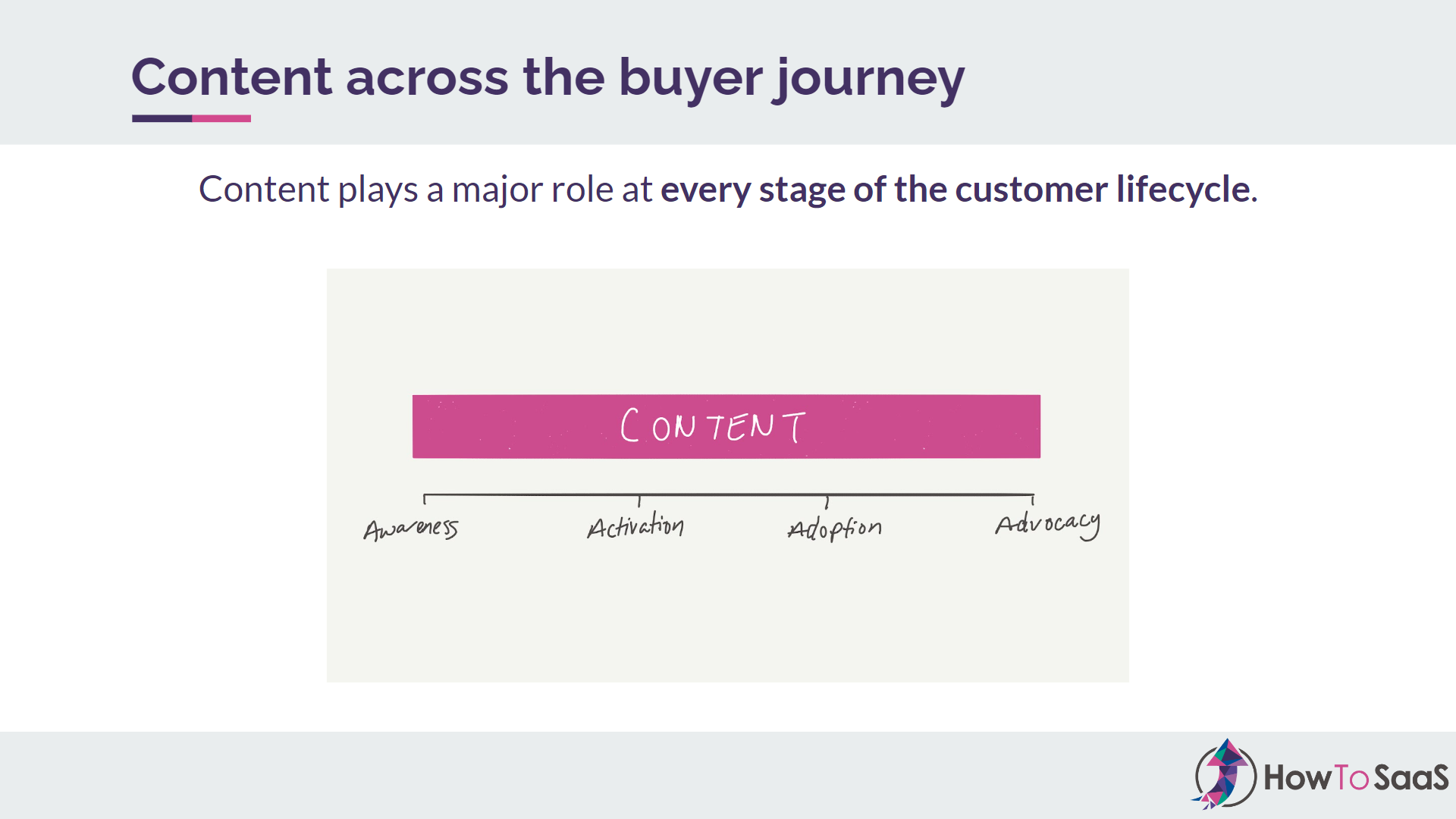
When you think about all the different roles content has, there are 10 critical roles that any content function has to fulfil. The struggle here is to juggle responsibilities across all these different domains:
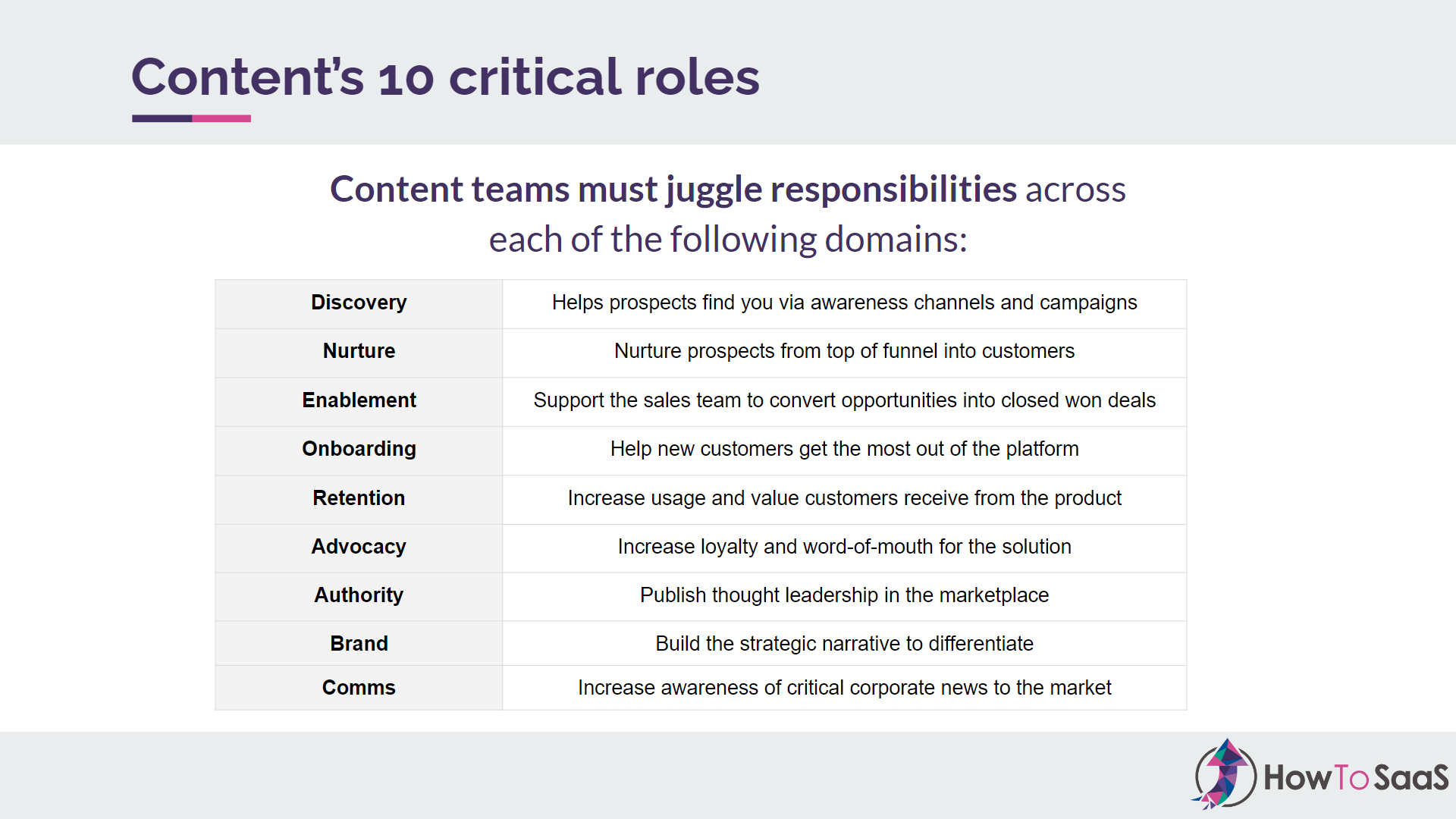
1. Discovery
Help prospects find you via awareness channels, and campaigns. This could be SEO, paid social, or speaking, for example. It's about driving awareness of what you have to offer.
2. Nurture
Talk to prospects and get them from wherever they are in their journey today through to the next stage. For example, if you're retargeting someone who shared their email address with you, you need to make sure you have enough assets to nurture that prospect to the next stage. Nurturing can happen via email, or via other channels like paid social.
3. Enablement
Support the sales team to convert more deals in your pipeline through to closed-won. That could mean producing the decks they need, the one-pagers or case studies that help them have better sales conversations and not just to follow up by asking ‘Hey, are you ready to buy?’.
4. Onboarding
Once you've closed the customer and they're ready to adopt the product into their organization, you need to help them get the most out of the platform so they stay with you long-term and don't churn in a year's time. This is where you might work with Customer Success, or with Product and a product-led growth model to help customers understand the different product value points and how to get the most out of that function.
5. Retention
Increase usage and the value customers receive from the product on an ongoing basis. For example, if you’re selling software that helps them generate more revenue for their organization, is their revenue climbing over time? Are the number of transactions going up over time? Do they see more customers coming through the platform over time? You want to educate customers on how to leverage all the product’s functionality to get to a point where their organization is almost dependent on the product to succeed and the customer's better off for it because they're producing more value for the organization.
6. Advocacy
Look at how to increase loyalty and word of mouth for the solution. This is also where you turn customers into advocates. You might focus on building campaigns that target your top verticals or use the insights you've learned from your best customers to determine what do with your demand gen or awareness campaigns. This might include what you have in your product and what you put out as product marketing.
7. Authority
This is quite different from the rest. Until now, we've been talking about what's required at each stage of the funnel and life cycle, and how we get the customer or prospect to get the most value so they move on to the next stage. But with authority, it's about building a better presence in the marketplace so you have more gravity and win more of those commoditized battles. So, if you're selling sales enablement software and there are 10 players out there, you need to differentiate yourself beyond just your features. You have to tell a better story that resonates with that market and gets them into your funnel.
8. Brand
Brand is connected to that authority piece, which might include thought leadership content. Brand is about your positioning, messaging and strategic narrative, how that connects to the rest of the marketplace, and how you differentiate yourselves against competitors and other solutions that are out there.
9. Comms
This is more like admin tasks associated with the marketing organization, but it does fall on the shoulders of Content. You might have critical corporate news, for example. Let's say you've acquired a company - you need to communicate that to customers or to the market in a press release or PR-oriented campaign, and somebody on the marketing team needs to create it.
The Right Order to Create Content
When you think about the order of creating content, look at this very simple framework. If you're a startup or a single product company, this framework is probably good enough to build version one of your content roadmap.
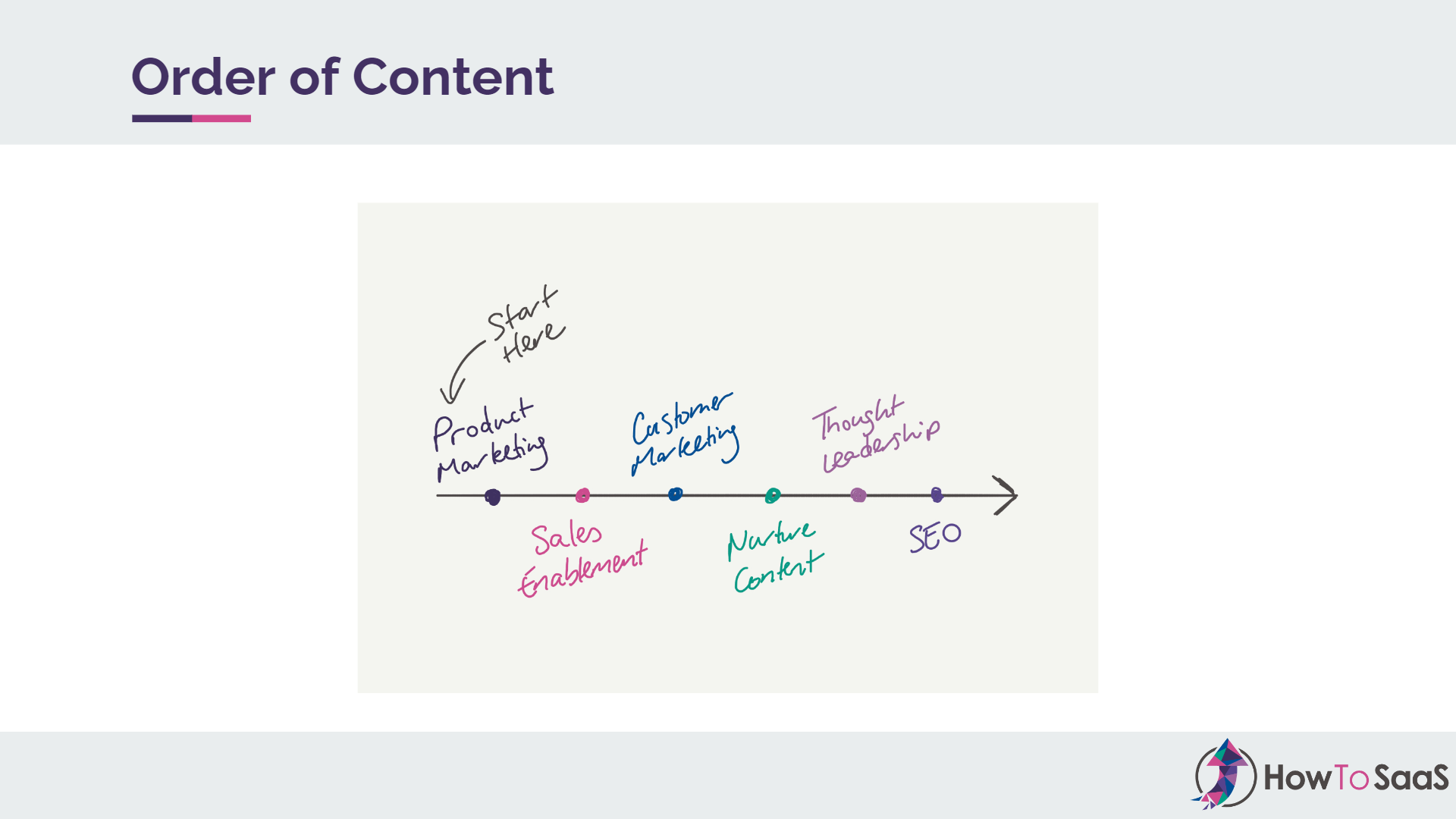
1. Product marketing
What are the core product marketing assets you need to convert customers?
This could be basic website content, or basic resources that you have email or for sales. This connects directly to...
2. Sales enablement content
These are the decks Sales have, the conversations they're having through their email cadences, and the call scripts they use.
3. Customer marketing
Usually, your warmest lead will be an existing customer, so starting there for demand gen is usually a good idea, especially if there are upsell or cross-sell opportunities. As you resolve those, you work your way towards...
4. Nurture content
These are prospects that are further down the funnel and need some additional attention or education to get to the next stage.
5. Thought leadership and SEO
These assets focus on driving prospects to the top of the funnel.
If you take this framework and turn it into the top 10-20 assets your organization needs to produce, you'd probably come up with a different list of priorities than if you were just to build an SEO roadmap out, for example. Maybe there are a ton of searches for a specific keyword related to your business, but likely that doesn't need to be top of your list.
Challenges Content Teams Face
A big challenge we come up against is that even though many of the earlier assets are often missing, and that content teams know this, the teams are pulled in different directions. Often, they don’t have enough resources to meet the expectations.
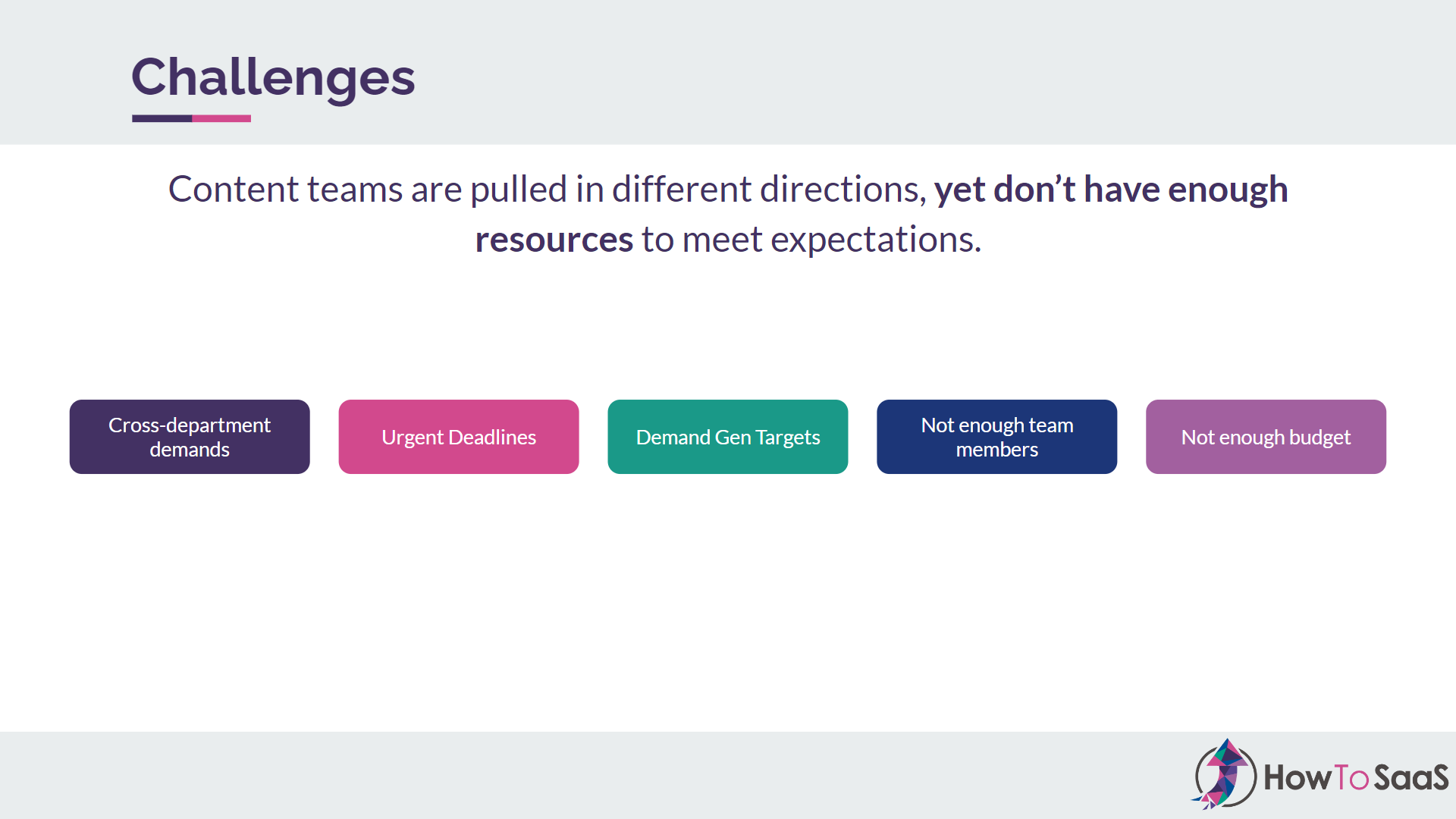
1. Cross-department demands
There's a ton of other forces at play that distract content teams, including cross-department demands. There might be resources or customer emails that you need to build to support an M&A transaction, for example.
2. Urgent deadlines
Maybe there's a new feature that's about to be released from the roadmap and you need a blog post explaining the feature release and what it will help customers do better. Or maybe there's an imminent pricing increase you need to communicate to customers.
3. Demand gen targets
There are likely demand gen targets or campaigns you need to support. Let's say the paid media team is launching paid social campaigns and they need certain assets to run those campaigns. Maybe it's a landing page, a white paper or a downloadable asset you need to build out, or a webinar you need to run.
4. Not enough team members/budget
Content teams soon run into problems where there aren't enough team members or budget and they don't have enough time to work on all of these things.
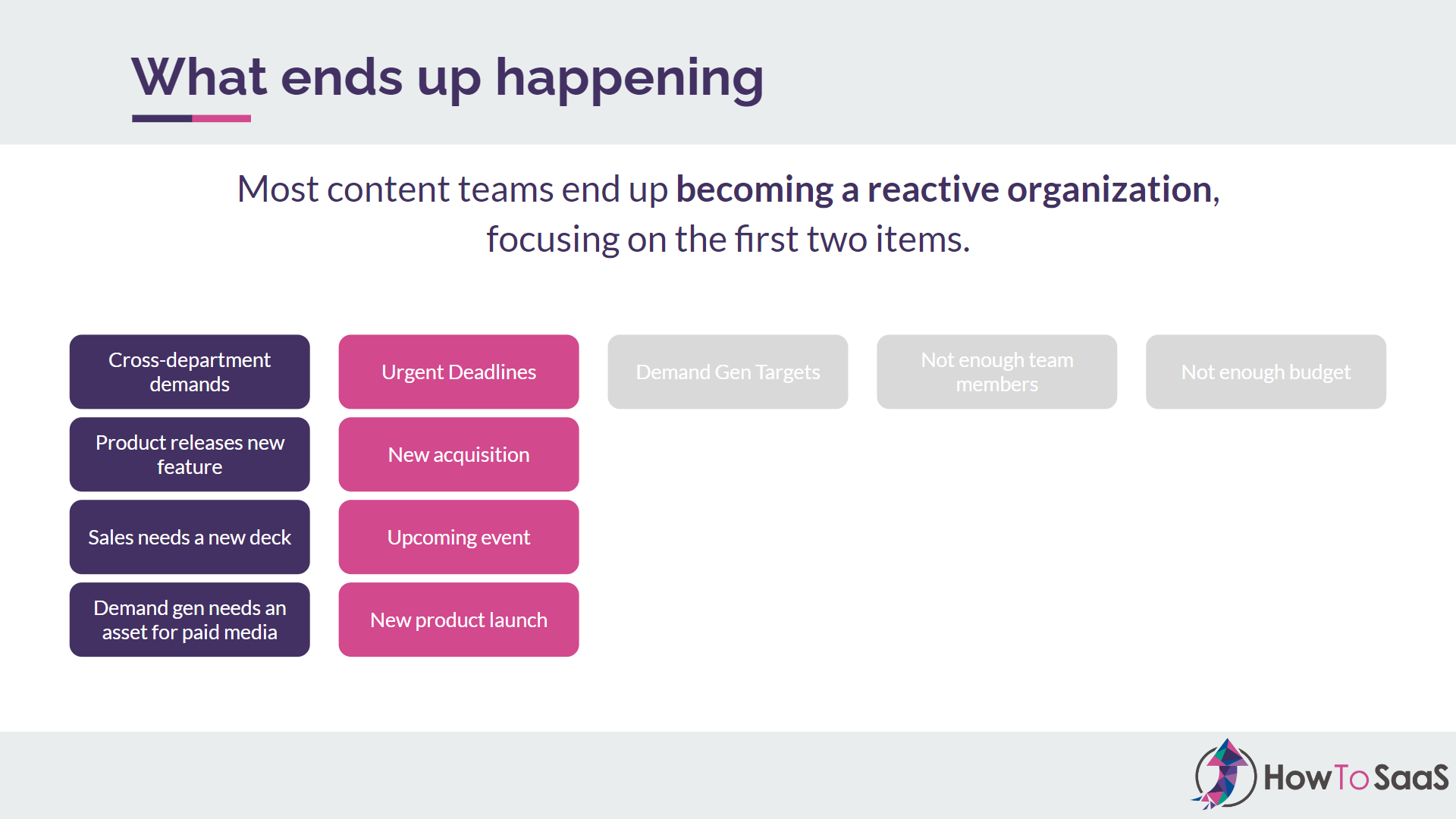
What ends up happening here is that instead of focusing on the three items on the right - demand gen targets, increasing headcount and budget - which are where a ton of value can be created, content teams focus on cross-department demands and urgent deadlines.
Ultimately, revenue growth is going to come from us supporting enough demand gen programs and whether there are enough content resources to convert people into customers. If we don't have the resources, that’s not going to happen. Or if we don't have enough budget, that's not going to happen.
But, instead, teams focus on meeting external demands and deadlines. If there's a new product launch or an upcoming event, it becomes all hands on deck creating content for those items.
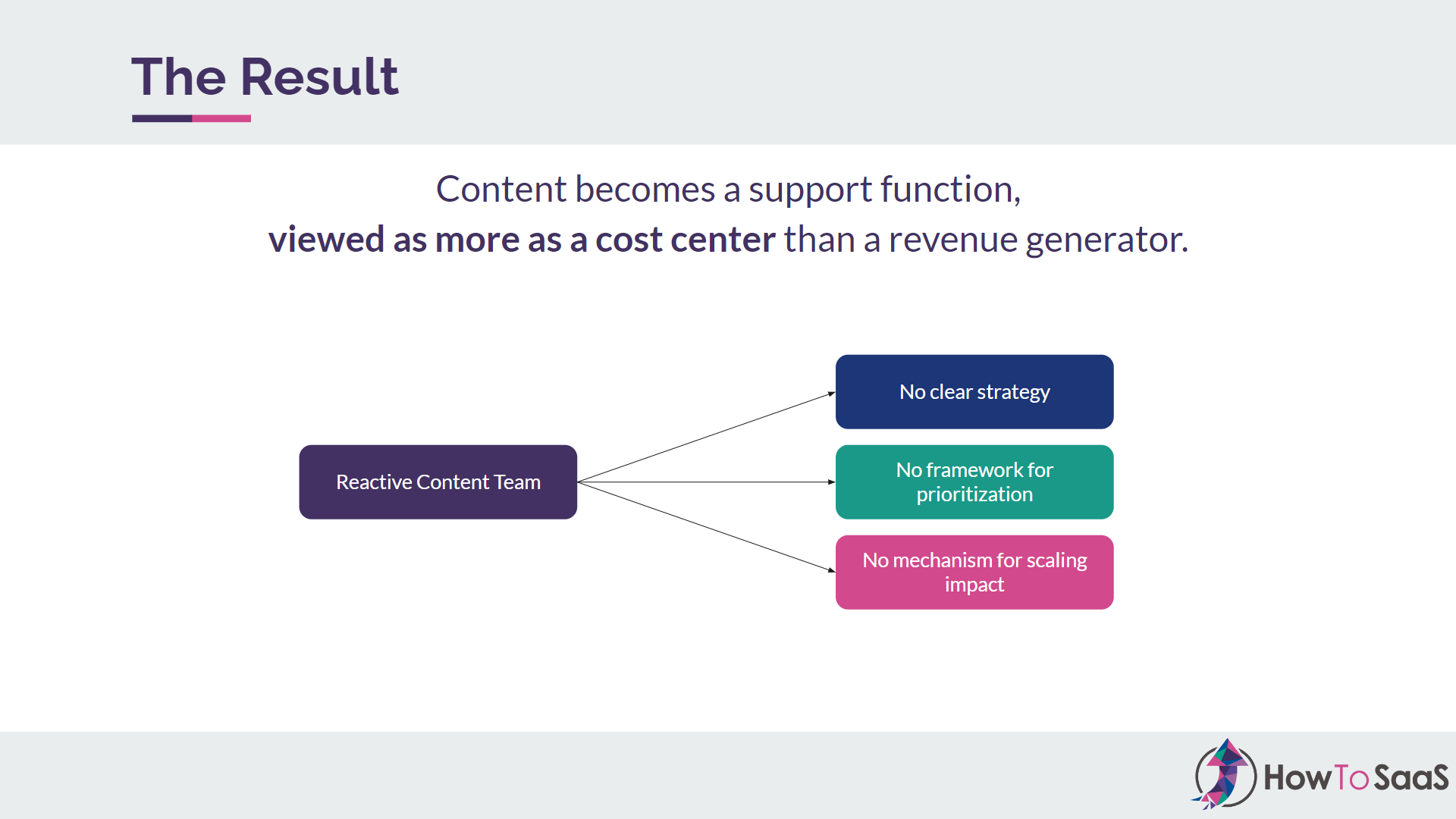
The result is that content ends up becoming a support function. It's often viewed as a cost center instead of a revenue generator, and the content team is primarily reactive.
The Solution
What we want to avoid at all costs is where there's no clear strategy, no framework for prioritization, and no mechanism for scaling impact.
Instead, we want a content team that is proactive and has a clear strategy. We need a ruthless form of prioritization.
One of the biggest mistakes content teams make is having no framework in place to say no. So, if Sales needs another one-pager, should that actually be your priority? Or is there something else more important and you should be saying no to these people?
If we have no mechanism for scaling impact or no way of measuring how we're doing, then it’s difficult to get additional budget that helps us scale our impact. And we need more budget so we can get more content marketers on the team to produce more assets and make a bigger impact on the overall growth of the organization.
So how do we fix this?

First, we need to prioritize the content efforts by tying priorities to the overall company strategy.
The idea is that our functional strategy for content should be informed by our overall department strategy for marketing, which should be defined by the overall company strategy - it should not be the other way around.
A lot of content teams get stuck in the trap of starting with their functional strategy. So, for example, if I'm a content marketer and I see opportunity in SEO, I could be doing a great job in SEO and may have even increased top of funnel traffic by 5,000-10,000 visitors over a 1-month span. But if in that time the number one company strategy is actually cross-sell/upsell and that's where the biggest leverage is, my function has actually failed its job.
What we want to do is to understand what the top-level items are at the company level and work down to the content strategy - instead of the other way around. Even if there are some good opportunities available, we have to say no to those things so we are aligned with the overall business and not siloed as a function.
That also increases our odds of getting more budget in the longer-term. Let's say we start with the SEO strategy, even though cross-sell and upsell were the priority. At the end of the year, it turns out we missed our targets on cross-sell and upsell, which were probably significant. Yes, we've done well with SEO, but because SEO was not core to what we needed to do, it makes it hard to lobby for additional budget for content because we didn't do what we were supposed to do.
A Method for Prioritization
The method for prioritization is to look at it through five steps:
- Start with the strategic priorities for the business. Understand what those levers are and what is being discussed in management meetings and at the board level.
- Look at the revenue opportunity inside those levers.
- Connect that to the financial targets you have for the business.
- Look at your funnel efficiency and where the biggest opportunities areas are.
- Identify overall buyer journey gaps.
All of these items are inputs to help us figure out what the right content roadmap is for our particular function.

Let’s take a deeper dive...
1. Strategic priority

If we start with number one - strategic priority - and look at the goals of Company A here, it might be that the biggest strategic levers identified in this business are to increase website traffic, increase trial to paid conversions, and increase customer adoption of a new payment processor.
On the flip side, if we look at Company B, the number one priority is to cross-sell to the existing customer. They also want to target their dream 100 customers. and there are pricing increases coming that they need to communicate to existing and new customers, and there's a ton of content work to do around that.
We can easily see that the content roadmap for Company A would look very different than the content roadmap for Company B. It could be that they have different business models. It could be that they're at a different stage in their journey. Or it could just be that the opportunities in each of these items are just quite different.
Depending on what these items are for each business, they're going to need different people on the content team. For example, if they're targeting the dream 100 customers, they likely need marketers that are well versed in ABM. But if they're trying to increase website traffic, they likely need marketers who are more focused on SEO or paid search.
2. Revenue opportunity
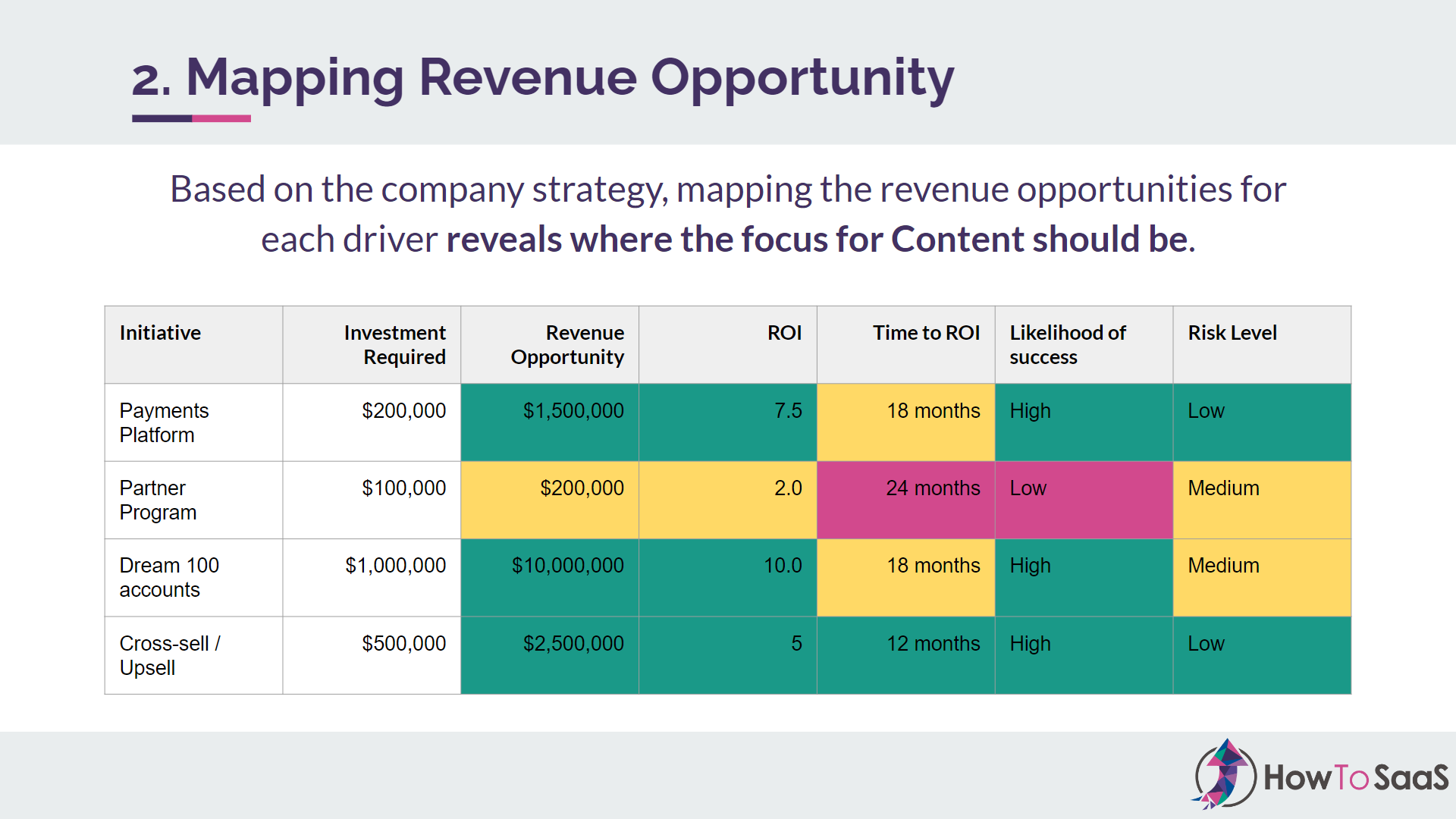
Next, we want to map the revenue opportunity that's available to us.
Let's take some of the items here and build out a basic data model to understand how we evaluate these opportunities.
For example, if we're talking about a payments platform:
- We might need $200,000 to capture the value that's available there.
- Let’s assume the revenue opportunity is about $1.5M if we have adoption from our existing base of customers.
- So there's about a 7.5x ROI if we put in $200,000.
- In terms of recovering this, it might take us 18 months but our likelihood of success is quite high and the risk level is low because these are existing customers. They're already using our product and there's not a lot we need to do to get them into our payments solution.
Conversely, we might have an idea that we need to launch our own partner program to increase adoption or help customers onboard onto the solution:
- The investment here might be $100,000.
- But there's minimal revenue opportunity - maybe only $200,000 a year.
- The ROI is 2x, which is still not bad.
- But to get a partner program up and running might take two years, plus there's so many complexities and distractions that the likelihood of seeing it through is quite low.
- So, while the risk level is low and we're only having to put in about $200,000, our likelihood of success is low too.
- We likely don't want to focus on this opportunity - at least to start with.
If you look at the dream 100 accounts:
- There might be a $10M revenue opportunity here because these deal sizes are huge - they might all be over $100,000 in average deal size.
- But to capture this, we need to produce a ton of one-to-one content to target those accounts and the contacts within them, so we likely need a lot more investment.
- Let’s say the investment is about $1M between headcount and programs.
- But the ROI is 10x, and higher than even the payments platform.
- The time might be 24 months, but the likelihood of success is quite high because if we know these are our ideal fit customers, they are worth over $100k to us.
- The likelihood of success is high if we execute this properly, but the risk level is also pretty high when we look at the million dollar investment.
The last one here is cross-sell and upsell:
- While we have to put in $500,000, there might be an additional $2.5M in opportunity because we've segmented our customers.
- Let’s say 30% of our customers are a good fit for this other product and that totals $2.5M in opportunity.
- This gives us a 5x ROI.
- With a motivated sales team, we could probably capture that in about 12 months' time.
- This is a pretty good opportunity for us, because the likelihood of success is quite high and the risk level is quite low.
Regardless of what business you're in - whether you're Company A or Company B - you want to have this kind of a model built out - at the department level, at the marketing team level. That should then flow down to the content team level.
For example, if we’re launching a payments platform, what assets do we need? Because this seems to be pretty high priority. Similarly, we want to list all our other items here too: we might have other product marketing campaigns here, other sales enablement, and SEO assets that need to be listed as well.
We need to compare that to these big levers that are available to the business and make a decision on which area we want to prioritize first. Given that we have limited resources, it's quite unlikely that we're going to get funding for all of it. So, where do we want to focus our resources?
3. Financial targets
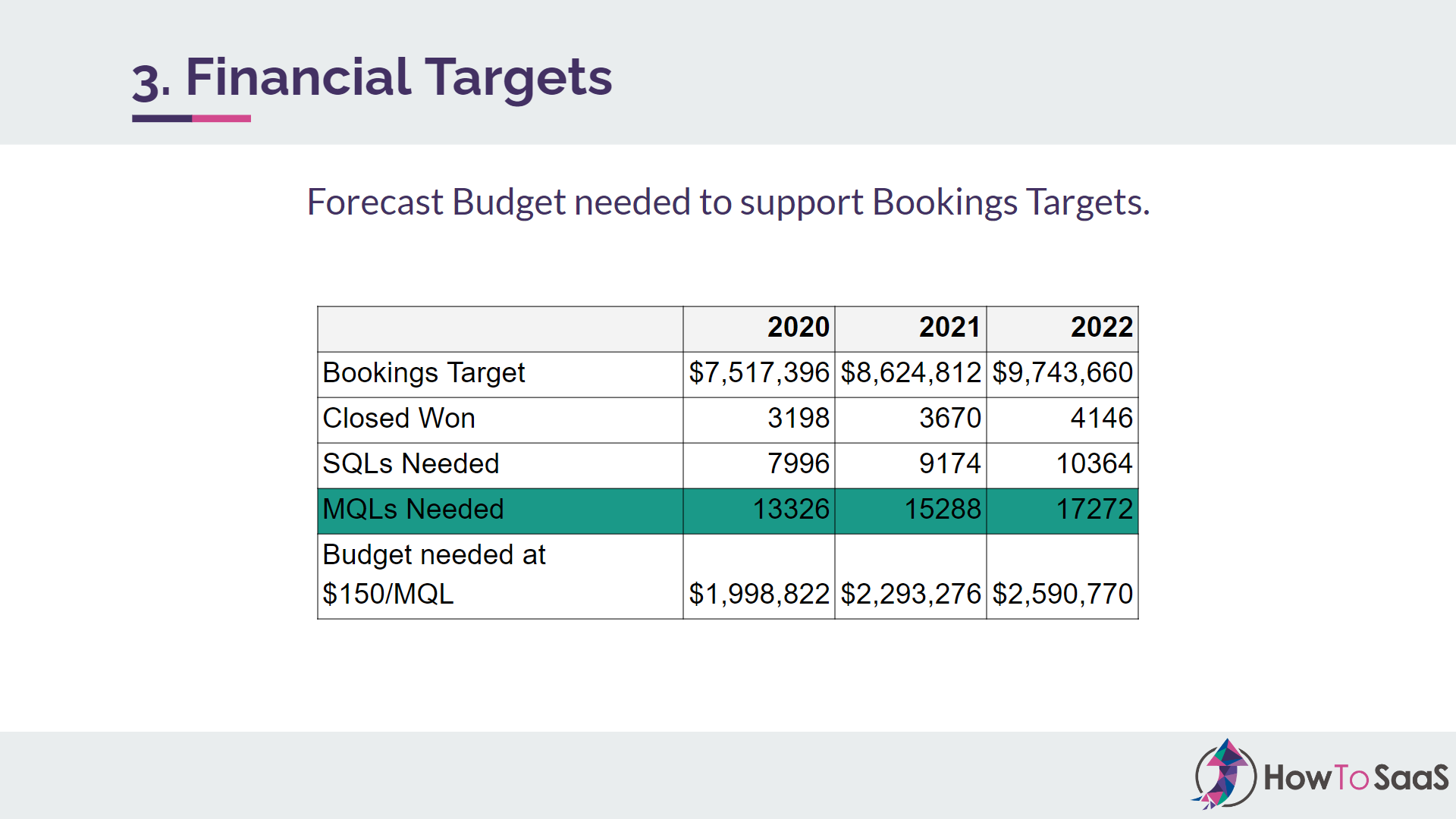
Look at your financial targets. Here, we're talking about net new customers. In general, these are usually one of the top items most companies are looking at, and you likely have financial targets for any significant initiatives.
For example, if you're talking about cross-sell or upsell, that’s likely in your revenue targets. If there's a pricing increase, that's likely in your financial targets as well.
We want to look at the budget and the bookings targets, see what we need to reach those targets from a marketing perspective, and then figure out what Content needs to do to help Marketing get there.
For example, in 2022, we need about 17,000 MQLs to hit our goal of closing almost $10M in bookings. Of that 17,000, how many does content need to drive? And which areas of content are those MQLs going to come from to help us hit those bookings targets?
From here, we need to work our way backwards to see which activities we definitely need to do to contribute to pipeline and what are the things we're going to cut from our prioritizing.
4. Funnel inefficiency
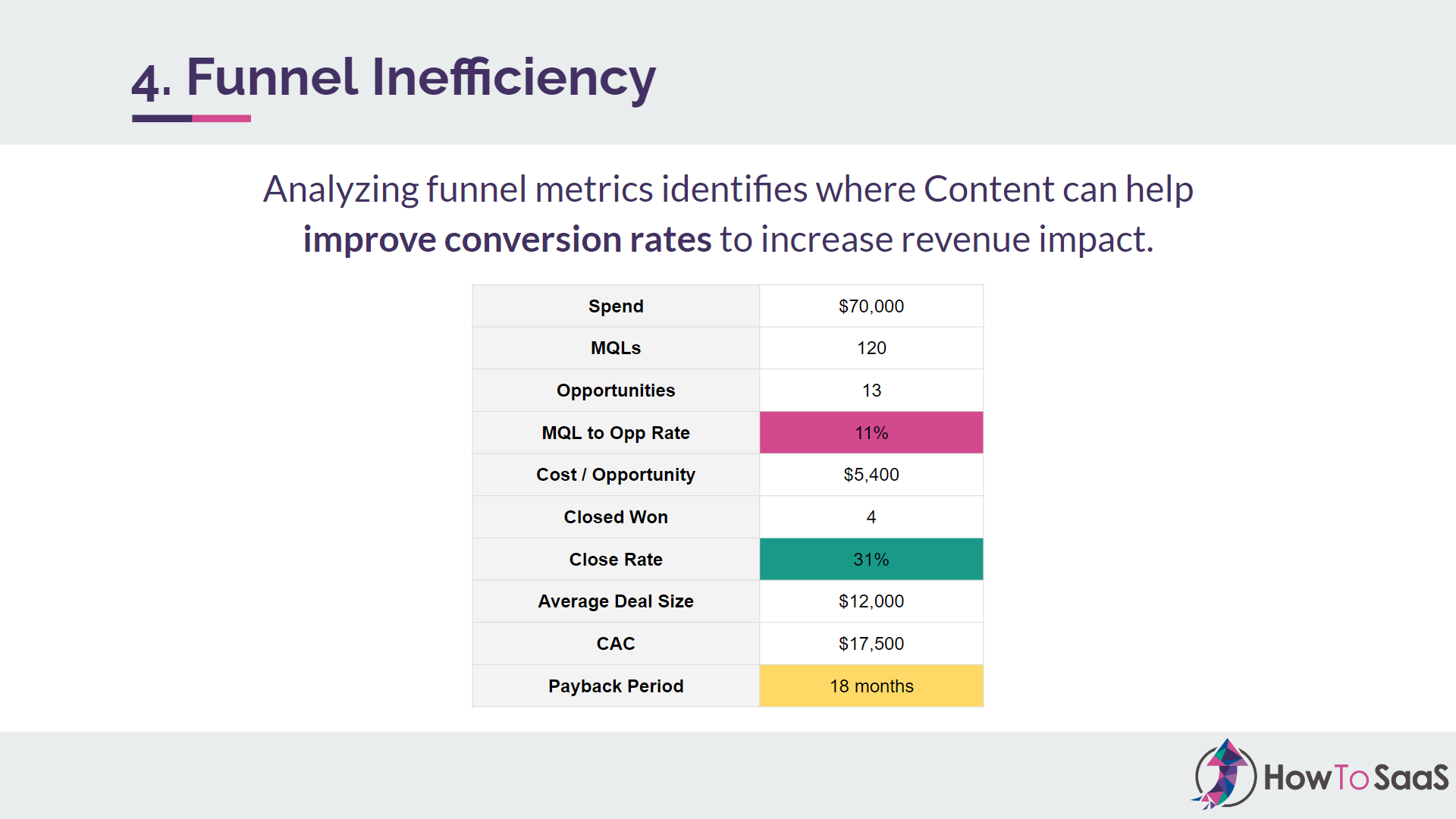
We want to look at the funnel efficiency of the business. This is a simplistic approach, but let's assume the above is our funnel for one product line.
Let's say we've spent $70,000 and have generated about 120 MQLs from that. We have 13 deals in the pipeline and close 4 of them.
From 120 MQLs, that's about an 11% conversion to opportunity rate, and about $5,400 per MQL for those 13 opportunities.
Then, there’s about a 31% close rate from those opportunities to the 4 closed-won deals, and an average deal size of $12,000.
Based on these numbers, our CAC to acquire each of these four accounts is about $17,500, and we make about $12,000 from that account. That means our payback period is about 17.5 or 18 months to recover our capital. 18 months is not ideal - we want this number to be below 12 months.
We can go back through the funnel and see where the issues are and where conversion rates really plummet. In this case, a 30% close rate on opportunities is pretty decent, but we can maybe improve that. Some world-class companies are above 40%, but 30-40% is usually quite healthy.
However, if we look at this MQL to opportunity rate, it's only 11%.
You can actually get way more complicated with this, because you can look at these conversion rates by channel, by campaign, by program, by geography, and by product line. If you were to have a massive spreadsheet with four product lines, it might turn out that the MQL to opportunity rate is problematic in two of them, whereas the opportunity to close rate is problematic in the other two. That now creates a different set of priorities. For the area that's the most problematic, you want to figure out what content can do to pump up those conversion rates.
5. Buyer journey gaps
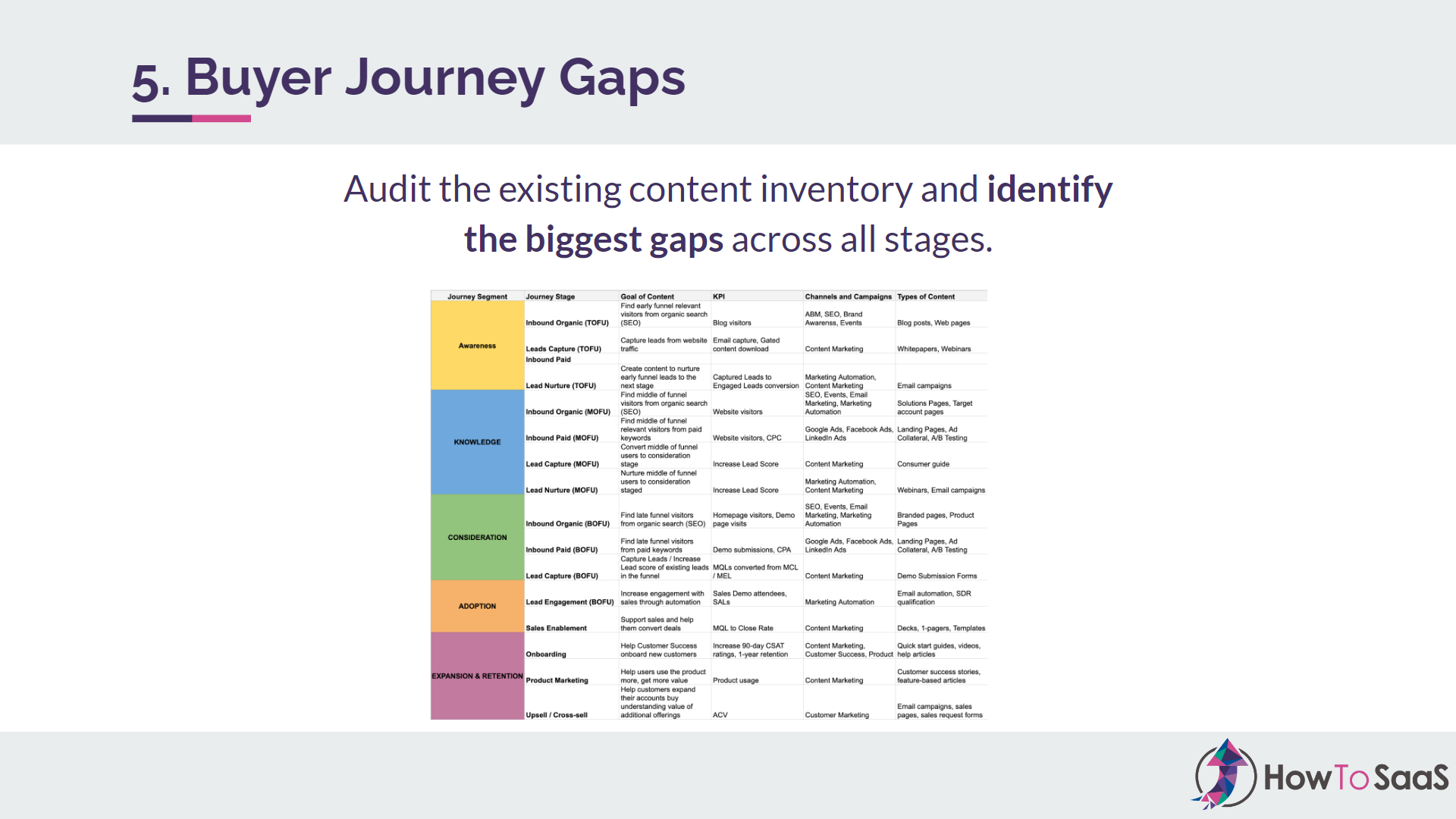
In step five, you're doing the buyer journey gap analysis. This involves looking through awareness, knowledge, consideration, adoption, expansion, retention, and advocacy across the board, and saying, ‘where do we have a ton of assets?’
In this case, it might be that we have a good amount of sales enablement, which is why we're able to close deals. Our sales team is effective and, overall, the sales enablement is in a good enough state. On the other hand, it may turn out that from an MQL to opportunity state, we don't have enough content or nurture streams or webinars or paid social campaigns or account-based targeting or segmentation. We likely don't have enough content to get customers through to closed-won or at least to opportunity status so that 30% opportunity to close rate can play a bigger role. Even if we can get the number of opportunities from 13 out of 120 to 20 out of 120, it will pay so many dividends down the funnel.
So, when you get to this buyer journey gap analysis and look at all those assets, you need to figure out where you’re lighter and whether you have a critical gap that's affecting conversion rates. If you do, prioritize that particular journey stage over others, even if there are a ton of good ideas around other journey stages.
For example, it might turn out that you have 5-10 other sales enablement assets that sales reps have requested from you, but you don't have enough of a nurture stream. You can deprioritize those assets requested by Sales because you have data as a form of saying no.
This is something that's missing in a lot of content organizations: the ability to say no with reason. Because of that, those content teams end up being more reactive.
Creating a Consolidated Content Roadmap

As we go through this process and look at all these different inputs, you want to take your strategic priorities, revenue opportunity, financial targets, funnel efficiency and the buyer journey to create a consolidated roadmap. This roadmap needs to focus on all the assets that should be highest priority and produced in the near term.
You can set up filters on this where you have, let's say, 5 sales enablement assets, 2 nurture streams, maybe a couple of SEO pieces of content, plus some corporate marketing materials. And then the rest is maybe priority 2, 3, 4, or it's focused for a later quarter because you just don't have enough bandwidth for that.
This can get way more complicated as you layer on additional product lines, geographies or languages when you’re trying to figure out where the prioritization should be.
Once you have that roadmap in place, this is where you want to go to ask for more budget.

Coming back to some of the levers we identified, we might say, ‘Hey, to launch this payment processor, we need about $200,000.’ And some of that spend might be on sales resources, some might be on marketing resources, but the content budget ask could be $80,000 for one product line.
For the partner program, it's just not something that we're going to work on right now because we have other things to work on, so we're going to have no budget asks for that.
But for the dream 100 accounts, we might need $500,000. That includes capital for two ABM marketers and some paid media spend.
For the cross-sell and upsell avenues, we need $80,000 and potentially a customer marketer to help us create those campaigns and target existing customers.
Immediately, we're able to ask for over $600,000 for content to scale in an environment where oftentimes content has one or two people on the team.
If you have multiple product lines, maybe there's one person per product line who’s really focused on content. And by tying their work to the investment committee planning, the budget forecasting and the revenue opportunity, we're now able to ask for significantly more budget and tie our work to revenue.
So now we're also revenue accountable. But we can ask for resourcing as if we are as well.
Immediately, you can see how this content team would grow by four people where previously they might have only had two content marketers. It's quite unrealistic to ask a content team of two people to do all four of these things. They could maybe do one thing at best, and everything else is more maintenance-mode work.
If we were to blow this out in different companies, based on their scenarios, you would have a much more fully built-out plan. But at a high level, this is roughly what it needs to look like as you're running through steps 1, 2, 3, 4 and 5, starting with the priorities and working your way through to the buyer journey gaps.
Ultimately, you want to end up here where your entire consolidated roadmap is connected to a budget ask, and content can secure more resources.
FAQs From the Community
In these questions, you'll learn:
- Prioritizing SEO when updating your website
- Prioritizing individual content projects
- Performance metrics for auditing content
- Which team should drive content needs
- Content agency vs in-house teams
- Calculating the budget ask
- Estimating budget without historical data
- Tying booking targets to strategic priorities
- Over-used content formats
- How many people you need in the content team
- Measuring content team capacity
- How to deal with budget allocation at the campaign level
From a product marketing standpoint, we're looking at revamping the web pages. Will SEO have to be considered a priority at the start rather than at the end?
Yes, if you're changing your website or changing web pages, SEO should definitely be a priority. The question that precedes that though is, is changing the webpage a priority in the first place? Or are there other priorities when you think about your model and all the other opportunities available to you?
For example, let's say the biggest revenue opportunity available to the business is to build out core messaging and use an inbound marketing approach. Maybe our paid search campaigns are not performing well because the quality scores are low and we see a ton of opportunity there. In this case, changing the website does make a ton of sense. But if it turns out that none of those things are actually opportunities and we're taking on the website work as more of a vanity exercise, then it may not be necessary to spend resources here to begin with.
But if you're down that path and you're changing your website, then yes, you want to factor in SEO. I would still limit the scope though, unless you’re missing a huge opportunity on the SEO side. So if you can find a way to simplify that process and quickly get to demand gen campaigns, that would be ideal.
How do you recommend prioritizing individual content projects within the roadmap?
If we're talking about standalone content projects - for example, if we're building a specific content asset and we're not entirely sure of all the different ways we're going to leverage it, or it's a little bit distinct from a company's strategic priorities - I would say those are fine. Every company has those projects where you're building certain assets - for example, to build the brand.
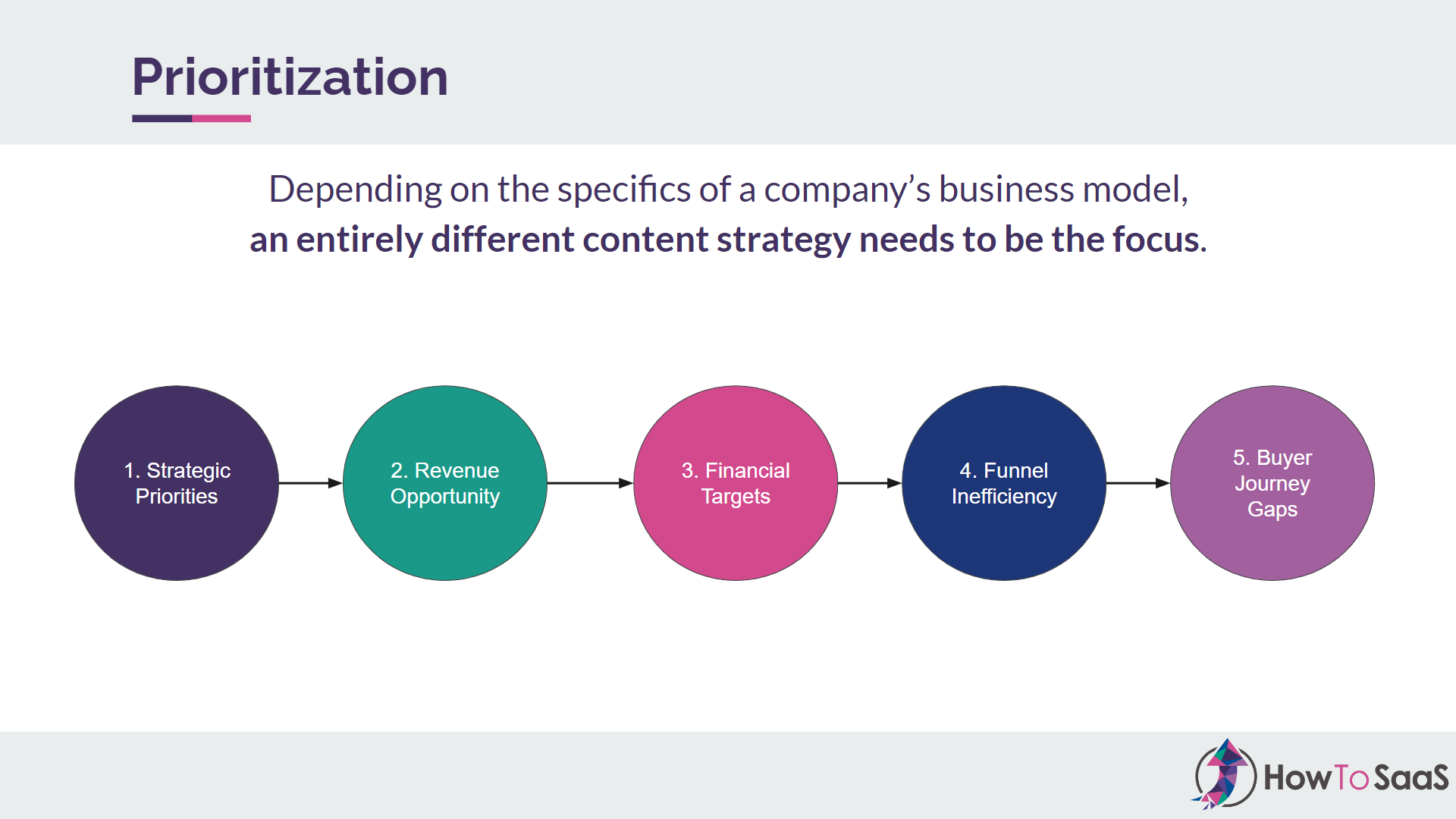
At the end of the day, whatever content project you're working on fits into one of the above buckets, whether it's discovery, advocacy, onboarding or authority. You have limited resources, so you have to trade off the time and effort that goes into creating that asset versus all the other things you can do.
It’s important to constantly be conscious of that trade-off, so when it's time to decide, ‘are we going to produce this?’, the next question is, 'where else could that time go?' You have to go through this exercise, and if you can say, ‘OK, we actually do believe this specific individual content project is a core opportunity for us,' you trade that off and make that decision.
If you're deciding to work on a content project outside of this framework because it's interesting to work on, or nice to have, or you’re really passionate about it, this often puts the team in trouble because there aren't enough resources. And that really shows when there's a quarterly board meeting, for example, or you're doing a quarterly business review, or you’re looking at your annual results versus what you budgeted or your revenue forecast.
What metrics should you look at when you're auditing existing content? What makes a piece of content a good piece of content?
It really depends. It's easy for an SEO asset where you can just look at organic traffic and conversions or top of funnel pipeline that's coming from that asset. But a lot of assets are not like that.
A nurture stream may just have the benefit of getting users through to the next stage.
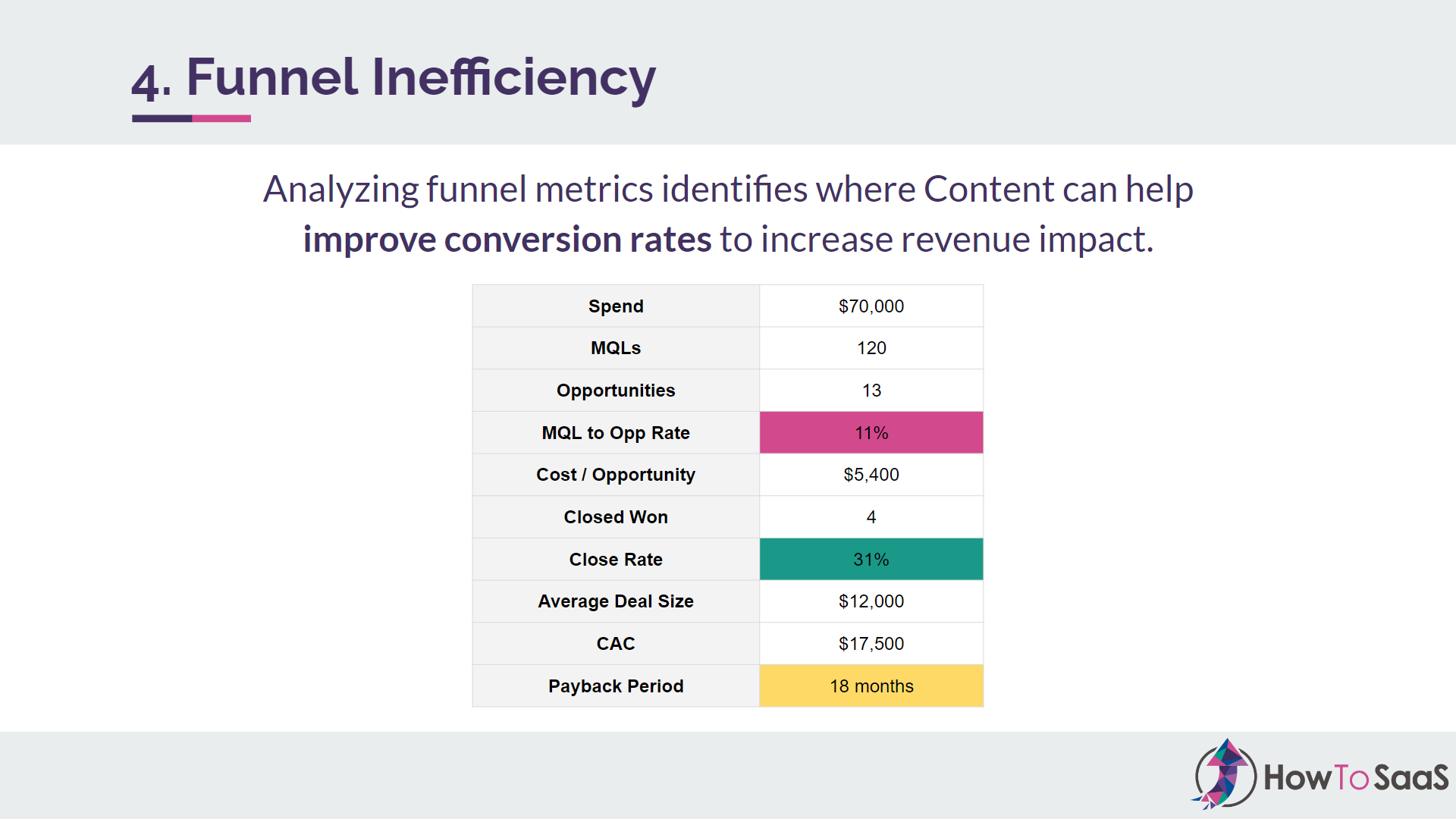
Overall, it's a combination of looking at funnel metrics, looking at every stage and seeing which piece of content plays a role at each point. Look at first touch for some types of assets and last touch for others, and then triangulate the truth as you bring all of those pieces of content or PR or metrics together to see if it’s actually working.
With that being said, one thing that would be essential for this company, for example, would be to A/B test different offerings or types of streams here to see if one moves them from 11% MQL to Opportunity rate to 13% or 15% because it's such a significant opportunity for this particular business.
A/B testing can be a great way of doing that, but you can also get caught in the cycle of optimizing something after it reaches a threshold of optimal performance. Perhaps after you got this number to 18%, for example, it's not going to go from 18% to 25%. Maybe the maximum is like 19%. So you always need to check that you're on the right track or if there's a better opportunity area for the business.
Which team should drive the content needs/types? Do campaign teams make content recommendations or does the content team need to study the campaign and recommend which types of content should be delivered?
I guess, in this case, the campaign team is different from the content team and they're collaborating on what needs to be prioritized together. This is a clear example of silos. Let's say your content team is a function, your campaign team is another function, and you also have demand gen and creative teams. That gives you four functions that are a subset of the overall marketing department. For one function to come with certain pieces of information and the other to either send or receive directives on that is really difficult.

Instead, all of this information needs to be brought to a department level and compared with the company's strategy. That should determine what’s the focus.
For example, if the campaigns team is siloed, they might decide to target the dream 100 accounts and need the content team to produce those assets. But it may turn out that that's not where content should be focusing their efforts. Perhaps cross-sell and upsell is a bigger opportunity.
Where is that determination being made? It can’t be made in the campaigns team because they're lacking some information there, and it can't really be made in the content team because they're producing content. It’s critical to have this conversation on where marketing should focus at the department level or even at the company level where the key leaders are in the room. Then, those decisions can filter down inside each of the sub-functions.
What do you think about working with a content agency versus an in-house team?
It's totally okay to work with a content agency, but you want the content agency to operate below the functional strategy.
If you’re relying on the content agency to define your functional strategy or department strategy, you're likely going to run into problems. You might have certain types of assets that are important based on where you're focused, but a content agency that's focused on SEO may have a different set of assets. Their entire filter is likely to be keyword research and difficulty, and what competitors are doing well. If we're in the e-commerce software space, for example, and every e-commerce player looks at the same data for keyword difficulty, competitors and search volumes, everybody's going to end up prioritizing the same keywords, whereas we actually want to be different to competitors and have different strategies and focus areas.
Once you’ve made the strategic determinations, the agencies should be executing on your roadmap. They may even bring information to you, e.g. the research or volumes that they found. You can take that as an interim, connect it to the business strategy or department strategy, combine that and give it back to them to say, ‘these are the assets we actually want you to work on.’ The agency doesn't get to decide what's a priority for you because they just don't have all the information.
Every once in a while, you will find an exceptional agency that asks you all the right questions to be able to do this work. But it's definitely rare - you almost need a C-level marketer to be able to do that type of work.
In the slide asking for more budget, how did you come up with the figures under the column Budget Asks? Was it a percentage of the overall investment required or the overall opportunity?
This is just more of an example. It depends on the situation. I made up the number of $10M as a revenue opportunity. It's something that we see often - dream 100 accounts are worth at least $100,000 in general.

Now, if we want to capture every dream 100 account and they’re worth so much money to us, they should have one-to-one content. So to put $100,000 as an investment here is just not realistic. Maybe that covers hiring one person, but how much one-to-one content can that person really create? We need maybe three or four people to capture this opportunity. We also need a dedicated roadmap for a couple of years to get the value out of this revenue opportunity. So that's why I put the $1M here.
I put $500,000 as an initial ask so we can get some initial resources, bring back metrics, prove out the model, and then ask for the additional budget.
What is the best way to estimate the budget you need for prioritized initiatives so you can frame the budget ask when you have no historical data to base that on?
If an initiative is prioritized, you may not have historical data that talks about conversion rates, but you most definitely have financial targets and you have the ability to map the revenue opportunity. Those two things are additional data points you can use to build the business case. You can use third-party resources, assumptions or benchmarks - these are quite underrated in building the right business case. They can help you say ‘here's where we think we should focus more of our efforts based on having more bonafide numbers for our financial targets and the revenue opportunity that's available.’
Is the bookings target linked to a specific strategic priority? Similarly, is the funnel efficiency related to gaps in the strategic priority?
These are examples, but what we actually want is to do this work for every strategic priority.
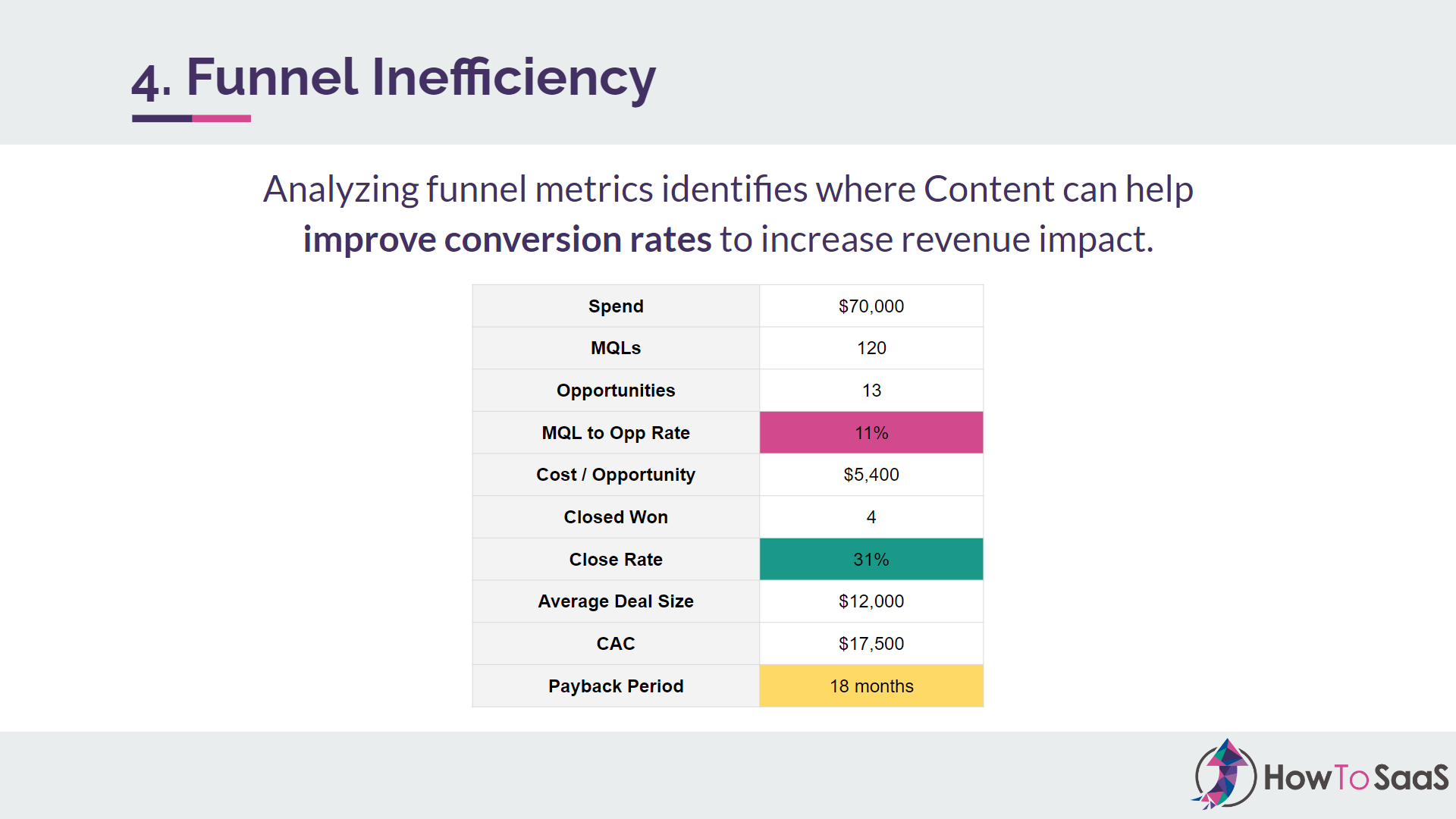
I could build a similar model for cross-selling, for example. The numbers here would be different. Let's say that across 1,000 customers, 300 of them fit into a cross-sell potential bucket. Out of the 300, we know that we've already sold 50 of them. Another 75 of them have said they're not interested or are not in the market today. So that leaves the rest - 175 - for us to go target. Those are the people we now need to focus on. If we were to target each of those people, what are our conversion rates when we leverage sales and marketing and try to get them into our funnel? And now I have a model for that.
Similarly, you would do that with a payment processor, or a dream 100 accounts, or any other campaigns you're running. The idea is to look at all of these metrics for each one and then bridge that into an overall marketing or content model to say, ‘here's what we need overall because here are the biggest gaps.’ You could do this for every lever, every product line, every geography, and even language.
If you're a much larger company, the complexity increases very quickly, so you need a way to simplify that. And when you come to a board meeting or an executive meeting, you need to be able to explain that within a couple of slides. This is just one version of that, but, ideally, you have something a little bit more complex.
Are there any content formats - for example, white papers, or super-long blog posts - that you think are overused?
The medium to me is less relevant. There’s a ton of stuff out there about gating content versus not gating, whether we should we do webinars anymore, and about video versus blog posts. Those things change all the time.
The main thing is: are you helpful to the customer? And what is the best way to be helpful? Which channels should you use? The medium you should use can vary. In some cases, you do a video and a blog post, or maybe a long-form piece and a podcast. Maybe it’s a gated piece of content that gives you information, or maybe it's ungated, or maybe it's both depending on the channel where you're promoting it.
I like to think of it as like a professional athlete - they have so many different tools they can rely upon when they're making decisions in very quick sequence. But they're able to pull the right tool out of the toolbox to make those decisions. Very similarly, as a marketer, some of those items can be used almost interchangeably depending on the situation. In some cases, they'll be more relevant; in other cases, they'll be less relevant.
How many people do you think marketing teams need to carry out the strategy with all the steps and content that needs to be done?
We did a webinar a couple of weeks ago on the ideal marketing team structure. If, as in our example, you had those four major campaigns going on, the team better be at least 15 people. Think about the bandwidth it would take to execute on those projects plus standard maintenance marketing work, plus demand gen work, plus everything else you do.
We have seen companies that have these kinds of strategic drivers and the marketing team has less than 10 people - often less than 7 or even 5. And that is a recipe for disaster.
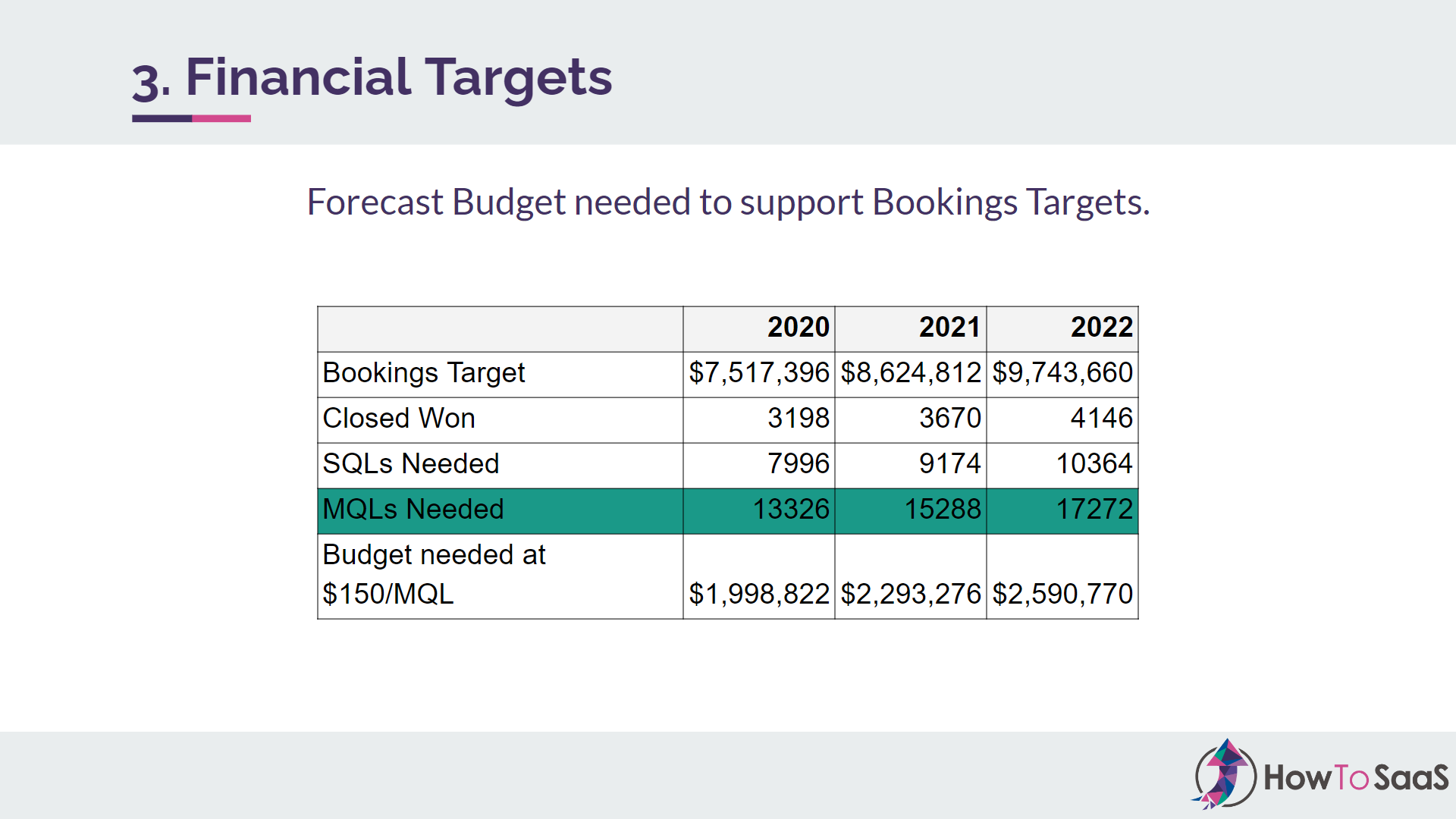
This is why the budget ask piece is so critical. If you are a content marketer and you have all of these items on your roadmap or you're being pulled in different directions, I would argue that your biggest lever is actually not creating more content - it's to do this work and get more resources.

If you can successfully lobby for more budget, everything else will become easier. And the way to lobby for more budget is to do all this work. From there, the execution is simpler.
You can get people that have expertise in creating different assets - emails, videos, etc. But getting the budget, the organizational buy-in, and the internal education around that - presenting to the board or having the right data to back it up - that's really where the bulk of the value is. Evolving into a content leader that can tell the story in that way to lobby for additional budget is definitely key.
How do you measure content team capacity?
As we're looking at these items, you want to figure out whether you need 2 marketers or 10 marketers. Think in terms of FTEs or full-time employees - for all the areas we're working on, how many FTEs are required?
It might turn out that to make the payments platform a reality and to promote that properly to our base, we actually need one, two, or even five FTEs. So, theoretically, you could ask for more than one product marketer. But, to be conservative, you'd start with one to generate proof points.
How you estimate that is to look at what tasks or projects are involved in making that project or initiative a reality. For something like the payments platform, we might need to produce a ton of educational resources for customers. We need in-product assets, help articles, email sequences, and web pages. And then there's ongoing sales assets you need to update, and assets required by customer support.
As you build out the projects within that initiative, try to assign some idea of how many hours each will take. Then total those hours together. Let’s say you think that to make this a reality, you’ll need 2,500 hours. And that's why we think it'll take at least one full-time person to work on this.
You actually want to do this for all the items that are a focus for you, and see if you can either reallocate some of those resources or even stop resources to some items altogether. For example, maybe you had half one person's time going into the partner program, but as you look at this list, you realize you need to put more time into the payments platform because there's so much more opportunity there. You may reallocate that person to the payments platform instead so you don't need to hire an additional person.
This is where org design planning, OKR planning, and reallocation of resources are important. Perhaps you ask for $600,000 in additional resources here, but you may only get $300,000. You’ll have to make some trade-offs. Maybe instead of targeting the dream 100, you start with the dream 20 or 25, or maybe even target the top five accounts to prove that out so you can then go get more budget.
Mapping it all out - all the content work against the roadmap and the OKRs - is how you get there, but that level of detail is essential to figuring out the right headcount.
What about organizations where budgets get allocated at the campaign/demand gen level and content follows suit to support the campaign? How do we decide on content needs in such a scenario?
If this is happening, somebody else has decided what the priority is for content. Maybe it's your CMO. Maybe it's the CRO. Maybe it's the CEO or the board.
We want to gather the intelligence from that level to understand what is a priority so that we can factor that into our plan. At the same time, we don't want to be delegated to a support function if we have information that can change those plans.
So, if someone has set the strategy to focus 100% on SEO and ignore cross-sell, let's say, and you have information about certain email campaigns that are doing a good job, it's your job to bring that data back from the functional level to the department level or company level so those decisions can be adjusted.
I understand that in some organizations this is easier said than done because of the hierarchy, so passing that information up can become difficult. But that's really the answer - you want to not just be an order-taker or fulfilment function, because then you're as good as an agency. You don't have any context. You're not plugged into the overall strategy. You're just executing. And the way to level up is to actually connect the work to the company strategy.
So either you get in that meeting, you get access to the notes from that meeting, or you bring your own data that gets you into the meeting… whatever you need to do to show up there and be able to contribute better.
Subscribe to SaaS Marketing Simplified!
Get bite-sized insights on SaaS marketing, growth and strategy in your inbox a few times a week.



